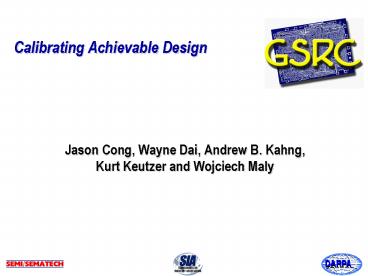Calibrating Achievable Design - PowerPoint PPT Presentation
1 / 8
Title:
Calibrating Achievable Design
Description:
New GSRC infrastructure for CAD-IP Reuse: The Bookshelf. 11/3/99. 5. Overview of Session ... CAD-IP Reuse via the GSRC Bookshelf. Igor Markov ... – PowerPoint PPT presentation
Number of Views:37
Avg rating:3.0/5.0
Title: Calibrating Achievable Design
1
Calibrating Achievable Design
- Jason Cong, Wayne Dai, Andrew B. Kahng, Kurt
Keutzer and Wojciech Maly
2
Achievable Design
Design Quality
Better Design Technology
- Technology dynamic CMOS, Cu/low-k, SOI, vertical
devices, ... - Quality power, speed, area, reliability,
cost/yield, ... - This Theme structural changes to CAD that enable
more efficient and effective development of
design technology
Better Methodology
Better Tools
?
Better Circuit Fabrics
Achievable
Evolutionary CAD
Technology
3
Time-to-Market and QOR in CAD
- Problem Currently takes 5-7 yeas to get a
leading-edge algorithm into production tools - Result Must solve todays design problems with
yesterdays CAD technology - Problem Published descriptions insufficient to
enable replication or even comparison of
algorithms - Result Cannot identify, evaluate or advance the
CAD technology leading edge - Issues for the entire CAD field
- productivity of CAD tool development
(time-to-market) - quality of the resulting CAD tools
(quality-of-result) - Our Solution Reuse
4
CAD-IP Reuse
- Componentized IPs for CAD ? plug-and-play solvers
for key problems - IP socket ? problem formulation data
interfaces test data QOR measures - Addresses the time-to-market problem
- CAD-IPs plug-and-play into alternative design
flows - reduce delays from invention to evaluation to
availability - ? shorter design cycle for new tools, rapid
prototyping of new flows - Addresses the QOR problem
- focus on the right problems ( mechanism to
specify these) - reduced barriers to entry for leading-edge
research - standards for evaluation, reporting,
documentation - ? more mature framework for developing new CAD-IP
- New GSRC infrastructure for CAD-IP Reuse The
Bookshelf
5
Overview of Session
- GTX The GSRC Technology Extrapolation System
- Dirk Stroobandt
- Future Axes for Achievable Design
- Wayne Dai
- CAD-IP Reuse via the GSRC Bookshelf
- Igor Markov
- A Metrics System for Continuous Improvement of
Design Technology - Andrew B. Kahng
6
Ground Truths
- Fundamental facts and data points that anchor the
process of bounding the achievable envelope of
design - ground truths must be identified and propagated
- Can be with respect to
- manufacturing process, materials, physical
phenomena - specific CAD optimizations of circuit
topology/embedding - system architecture and packaging
- Are properly extrapolated via
- "inference chains"
- response surface modeling and parameter
optimization - Drive the EDA vision of future design issues,
methodology - fundamental limits, fundamental truths, stakes in
the ground - current distribution, inductance extraction, UDSM
testing,
7
Example Ground Truths
- What is the maximum possible clock frequency for
a given process and die size? - When does inductance matter?
- What design tradeoffs must be made to maintain
reasonable supply currents? - What is the necessary number of package
pins/balls for power/ground distribution? - At what geometries, supply voltages will domino
lose most advantages over static CMOS? - What is an optimum design strategy from a
manufacturing cost point of view?
8
Metrics
- Design optimization must be founded on
- an understanding of what should be optimized by
which heuristic - an understanding of design as a process
- Metrics supports ideal of "measure, then
improve - design becomes less of an art and more of a
formal discipline - design process optimization enabled through
framework of recording, mining, measuring,
diagnosing, and then improving - Infrastructure
- hoped-for proactive initiative from EDA
vendors - reality for now, will use Perl scripts around
existing tool logfiles - guidance from designer and design tools RD
communities (i) what should be measured, (ii)
data mining / visualization / diagnosis
infrastructure, (iii) project-specific design
process data collection































